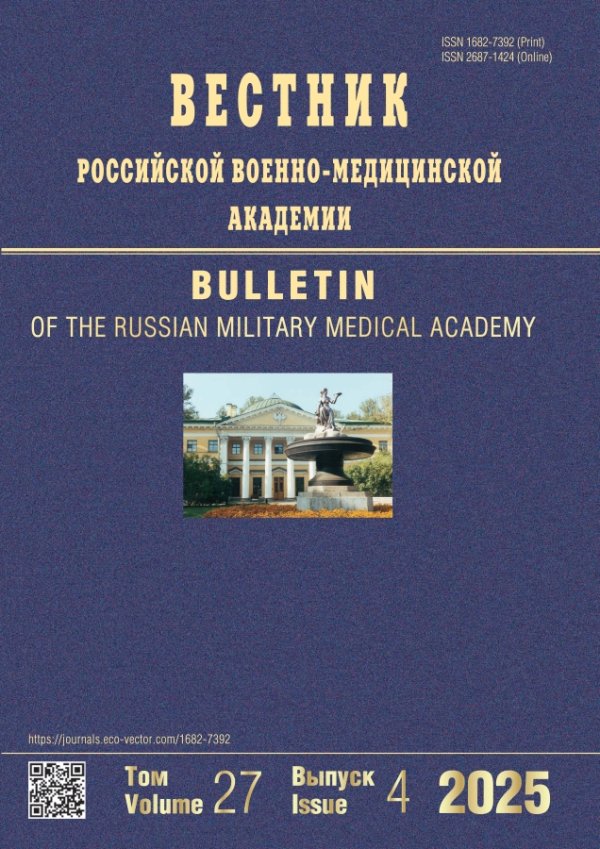Возможности допплерографии в оценке внутрипочечной гемодинамики у больных сахарным диабетом 2-го типа и хронической болезнью почек
- Авторы: Шипилова Д.А.1, Нагибович О.А.1, Щукина Н.А.1
-
Учреждения:
- Военно-медицинская академия им. С.М. Кирова
- Выпуск: Том 22, № 3 (2020)
- Страницы: 99-102
- Раздел: Клинические исследования
- URL: https://journals.rcsi.science/1682-7392/article/view/50542
- DOI: https://doi.org/10.17816/brmma50542
- ID: 50542
Цитировать
Аннотация
Резюме. Рассматриваются возможности допплерографии в оценке внутрипочечной гемодинамики 72 стационарных больных сахарным диабетом 2-го типа, осложненным хронической болезнью почек. Установлено, что ренальная гемодинамика вовлекается в патологический процесс уже на ранних стадиях диабетического поражения почек. Нарушение внутрипочечного кровотока у больных сахарным диабетом 2-го типа выявляется за счет снижения минимальной скорости кровотока и повышения показателей внутрипочечного сосудистого сопротивления. Выявлена взаимосвязь между допплерографическими показателями и почечными параметрами, а также некоторыми характеристиками больных, такими как возраст, длительность заболевания, уровень гликированного гемоглобина, что указывает на патогенетическую роль этих показателей в развитии диабетического поражения почек. Наибольший вклад в изменение ренальной гемодинамики вносят креатинин сыворотки крови и скорость клубочковой фильтрации. Повышенные значения индекса резистивности выше 0,7 условных единиц, индекса пульсационности выше 1,54 условных единиц и систоло-диастолического соотношения выше 3,8 условных единиц являются ультразвуковыми критериями поражения почек. У больных без стандартных признаков хронической болезни почек диагностически значимый индекс резистивности при допплерографии выявляется в 72% случаев, индекс пульсационности – в 50%, систоло-диастолическое соотношение – в 28%. Исследование ренального кровотока на уровне правой сегментарной артерии может использоваться для неинвазивной диагностики и оценки поражения почек у больных сахарным диабетом 2-го типа.
Полный текст
Открыть статью на сайте журналаОб авторах
Д. А. Шипилова
Военно-медицинская академия им. С.М. Кирова
Автор, ответственный за переписку.
Email: vmeda-nio@mil.ru
Россия, Санкт-Петербург
О. А. Нагибович
Военно-медицинская академия им. С.М. Кирова
Email: vmeda-nio@mil.ru
Россия, Санкт-Петербург
Н. А. Щукина
Военно-медицинская академия им. С.М. Кирова
Email: vmeda-nio@mil.ru
Россия, Санкт-Петербург
Список литературы
- Ворожцова, И.Н. Диагностическая эффективность лучевых и лабораторных показателей как маркеров ранней диагностики диабетической нефропатии у больных сахарным диабетом 1-го типа / И.Н. Ворожцова [и др.] // Современные проблемы науки и образования. – 2017. – Т. 2. – С. 36.
- Дедов, И.И. Алгоритмы специализированной медицинской помощи больным сахарным диабетом / И.И. Дедов, М.В. Шестакова, А.Ю. Майоров // Сахарный диабет. – 2019. – Т. 22, № S1. – С. 68–79.
- Капустин, С.В. Ультразвуковое исследование в урологии и нефрологии / С.В. Капустин, Р. Оуен, С.И. Пиманов. – М.: Умный доктор, 2017. – 176 с.
- Климонтов, В.В. Цистатин С и коллаген IV типа в диагностике хронической болезни почек у больных сахарным диабетом 2-го типа / В.В. Климонтов [и др.] // Сахарный диабет. – 2015. – Т. 18, № 1. – С. 87–93
- Клинические практические рекомендации международного общества нефрологов по диагностике и лечению хронической болезни почек, 2012 // Нефрология и диализ. – 2017. – Т. 19, № 1. – С. 59–61.
- Кошельская, О.А. Маркеры хронической болезни почек и нарушения ренальной гемодинамики у пациентов с контролируемой артериальной гипертонией высокого риска / О.А. Кошельская, О.А. Журавлева // Росс. кардиол. журн. – 2018. – № 10. – С. 112–118.
- Нагибович, О.А. Возможности допплерографии в диагностике функционального почечного резерва / О.А. Нагибович, Д.А. Шипилова // Medline.ru. Росс. биомед. журн. – 2018. – Т. 19, № 4. – С. 682–692.
- Шамхалова, М.Ш. Эпидемиология хронической болезни почек в Российской Федерации по данным федерального регистра взрослых пациентов с сахарным диабетом (2013–2016 гг.) / М.В. Шамхалова [и др.] // Сахарный диабет. – 2018. – Т. 21, № 3. – С. 160–169.
- Шилов, Е.М. Нефрология. Клинические рекомендации / Е.М. Шилов, А.В. Смирнов, Н.Л. Козловская. – М.: ГЭОТАР-Медиа, 2020. – 856 с.
- Bruno, R.M. Dynamic evaluation of renal resistive index in normoalbuminuric patients with newly diagnosed hypertension or type 2 diabetes / R.M. Bruno [et al.] // Diabetologia. – 2011. – Vol. 54, № 9. – P. 2430–2439.
- Dayem, S. Follow Up of Value of the Intrarenal Resistivity Indices and Different Renal Biomarkers for Early Identification of Diabetic Nephropathy in Type 1 Diabetic Patients / S. Dayem // Open Access Macedonian Journal of Medical Sciences. – 2017. – Vol. 5, № 2. – P. 188–192.
- Genov, D. Resistive Index for the Evaluation of Renal Damage in Diabetes Mellitus Type 2 / D. Genov // Open Journal of Internal Medicine. – 2018. – Vol. 8, № 2. – P. 160.
- Kim, J.H. Resistive index as a predictor of renal progression in patients with moderate renal dysfunction regardless of angiotensin converting enzyme inhibitor or angiotensin receptor antagonist medication / J.H. Kim // Kidney research and clinical practice. – 2017. – Vol. 36, № 1. – P. 58–67.
- Kopel, J Evolving spectrum of diabetic nephropathy / J. Kopel, C. Pena-Hernandez, K. Nugent // World journal of diabetes. – 2019. – Vol. 10, № 5. – P. 269.
- Mancini, M. Renal duplex sonographic evaluation of type 2 diabetic patients / M. Mancini [et al.] // Journal of Ultrasound in Medicine. – 2013. – Vol. 32, № 6. – P.1033–1040.
- Spatola, L. Doppler ultrasound in kidney diseases: a key parameter in clinical long-term follow-up / L. Spatola, S. Andrulli // Journal of ultrasound. – 2016. – Vol. 19, № 4. – P. 243–250.
- Sugiura, T. Resistive index predicts renal prognosis in chronic kidney disease / T. Sugiura, A. Wada // Nephrology Dialysis Transplantation. – 2009. – Vol. 24, № 9. – P. 2780–2785.
- Tai, H, Longitudinal follow-up study of the retrobulbar and intrarenal hemodynamics in patients with T2DM / H. Tai [et al.] // Medicine (Baltimore). – 2019. – Vol. 98, № 46. – P. 17792.
- Xu, H. Renal resistive index as a novel indicator for renal complications in high-fat diet-fed mice / H. Xu [et al.] // Kidney and Blood Pressure Research. – 2017. – Vol. 42, № 6. – P. 1128–1140.
Дополнительные файлы








